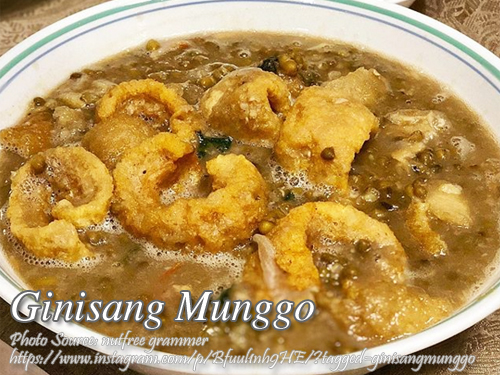How to Cook Ginisang Munggo
Ginisang munggo is a hearty Filipino mung bean stew simmered with pork, aromatics, and leafy greens, often topped with crunchy chicharon for extra flavor and texture.
Prep Time10 minutes mins
Cook Time1 hour hr 30 minutes mins
Total Time1 hour hr 40 minutes mins
Course: Vegetables
Cuisine: Filipino
Keyword: Filipino mung bean stew, ginisang munggo, ginisang munggo recipe, how to cook munggo, mung bean soup with pork, mung beans stew
Servings: 6 servings
Calories: 235kcal
Author: Manny
- 250 grams dried mung beans (munggo)
- 250 grams pork belly slice into strips or minced
- 5 to 6 cups water
- 2 Tbsp. cooking oil
- 4 cloves garlic minced
- 1 pc medium onion sliced
- 2 pc medium tomatoes sliced
- 1 cup ampalaya leaves
- 2 Tbsp. fish sauce patis or to taste
- 150 grams pork cracklings chicharon
How to cook Ginisang Munggo:
Rinse the mung beans in running water. In a pot, put the mung beans and water. Bring to a boil and cook until the beans are tender. About 45 minutes.
In a wok or deep pan, heat oil and stir fry the pork until brown. Set aside. Saute garlic and onion until fragrant. Then add the tomatoes and saute until soft. Mix the pork and add the patis and simmer for a few minutes.
Add the cooked mung beans with the liquid and stir. Add the bitter melon leaves, pork chicharon and cook for at least 5 minutes more. Serve hot.
Cooking Tips:
Soak the Mung Beans for Faster Cooking
Soaking mung beans in water for at least an hour before boiling can significantly cut down the cooking time. This helps soften the beans quicker and results in a smoother, creamier texture. It’s a small step that saves time and gas—perfect for busy home cooks.
Sauté Aromatics Until Fully Caramelized
Take your time sautéing the garlic, onions, and tomatoes until they're deeply golden and softened. This brings out their natural sweetness and adds depth to the flavor of the stew. Rushing this part will leave your dish tasting flat, so don’t skip the extra few minutes of browning.
Add Greens and Chicharon Last
Ampalaya leaves and chicharon should be added during the final minutes of cooking to keep their texture and flavor intact. Overcooking the leaves makes them bitter, and chicharon will lose its crunch if left in too long. Stir them in, simmer briefly, then serve right away for the best results. 